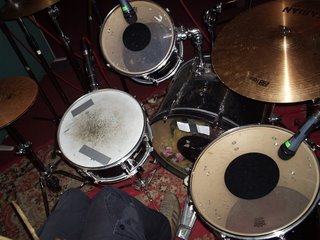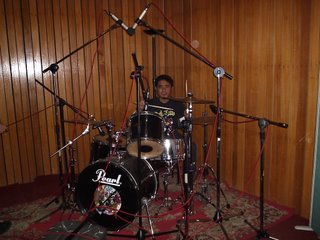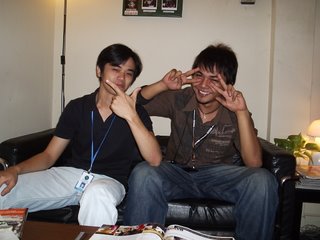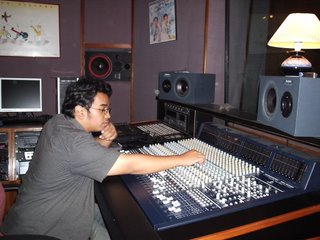Drum Micing / Monday, August 21, 2006
Ever wonder how a drum is mic in a recording? Here is an amatuer way of explaining a drum micing technique. Well, the first thing is to
be assured that decisions you are making in overall levels, eq, and reverb setting will actually work for the song it will be applied to. Then mic each kit with the appropriate selection of mic. Hmm theres no rules that says that you must use this mic for this and that, so it all comes back to what you want it to sounds like. Well for me, these are the mics that i used:
- Kick Drum - AKG D112 Mic
- Snare Drum - Shure SM57 Mic
- Hi-Hat - AKG C3000
- Toms - 2x Seinheiser E835S Mics
- Overheads - 2 x AKG C1000 Mics (better to have them as a pair of the same model)
Since each mic has a different frequency response, it is best for you to play with the micing position and listens to what original sounds like. If it has the tone but just not a bit there, try to EQ it and if you are still not satisfied, change the positioning coz even a slight adjustment could change the whole tone of the drum. Hmm to me, i always imagine the mics like a flashlight and you point it where you want to make it "lit"(brings out the tone).
Usually, for the kick drum, you have to place the mic inside and if you want more rounder sound, aim it somewer between the beater and the outer ring. If you aim it more towards the beater, u will get the punchy sound of the beater clearer. Try different angles, sometimes an off-axis mic placement would have a great overall tone but as i said before, they are no rules, just guide lines. Hmm but remember to make sure the signal doesnt clip, its ok to reach the peak as long as it doesnt clip.
The snares and the tom are quite the same except for the bottom side of the snare so therefore same guide applies for their mic placement. The outer ring gives you more of the brighter sound but as u get closer to the middle point, you'll pick up more of a body tone of the snare/tom. Try different positions and EQ if you have to. Below is a picture of the snare and toms and if you notice, theres a masking tape on the snare and the purpose for that is to make it much more tighter. hmmm but yeah, it all depends on wat you want.


Well the cymbals like drum kit has a thin bringht sound so therefore the close u get to the outer ring, the thinner it is, and the closer to the middle, you'll get more thicker tone but usually you dont have to mic the crash or the ride as the overheads will pretty much picks it up. Just to keep in mind that when you close or open the hats while playing, it will let out a breath sound if you didnt place it properly so make sure you listen carefully to what it picks up and also be careful not to spill tooo much snare sounds into your hats mic.

Well finally the overheads(or ambience mics).Close micing a drum kit can lead to sterilizing the sound, which can tend to sound unnatural. The overhead mics can bring the drums back to life by blending them back to a single kit, as well as giving the cymbals life and positioning them in the stereo field correctly. Hmm theres quite a number of ways to place this stereo pair, AB technique, XY and so on. I decided to mic em in XY so that it doesnt picks too much of ambience sound and to keep the drum in its place as what i notice, an AB pair would create a larger room tone but a XY pair would keep it in its area.
Here is how it looks like in total :

BTW thats not me...lol wish i could play the drums that well tho ^^. Hope this helps in some sort. Im open to any ideas as im still learning so pls do leave me comments and correct me if some of the stuffs that i said is incorrect.
>>>
A few random pics... / Saturday, August 05, 2006
Ever wonder how the students at my college looks like? Here's what will happen to you when you put your feet into ocean institute's territory...
When you've done too much recordings: When you had too much theory classes and you decide to sleep and imagine it:
When you had too much theory classes and you decide to sleep and imagine it: When you have a 6 hours gap between classes and decide to put on a show:
When you have a 6 hours gap between classes and decide to put on a show: The look you will have when a beautiful lecturer walks by:
The look you will have when a beautiful lecturer walks by: Then you decide to ask for a second opinion:
Then you decide to ask for a second opinion: Unfortunately you cant have her and so you look for a pole to express ur feelings to:
Unfortunately you cant have her and so you look for a pole to express ur feelings to:
Interesting, isnt it?
>>>
Ocean.... / Friday, August 04, 2006
I guess i should have done this and explain audio engineering a bit earlier. Anyway, what is sound or audio engineering?Audio engineering is a part of audio science dealing with the recording and reproduction of sound through mechanical and electronic means. The field of audio engineering draws on many disciplines, including electrical engineering, acoustics, psychoacoustics, and music. Unlike acoustical engineering, audio engineering generally does not deal with noise control or acoustical design. Much of audio engineering is also used in broadcast engineering.Lol i stole that definition from wikipedia.
Basicallly,
an audio engineer is someone with experience and training in the production and manipulation of sound through mechanical means. As a professional title, this person is sometimes designated as a sound engineer instead. An informal name might be a "sound guy" and/or an "audio guy". A person with one of these titles is commonly listed in the credits of many commercial music recordings (also in other productions that include sound, such as movies).
Audio engineers are generally familiar with the design, installation, and/or operation of sound recording, sound reinforcement, or sound broadcasting equipment. In the recording studio environment, the audio engineer or recordist is a person recording, editing, manipulating, mixing and mastering sound by technical means in order to realize an artist's or record producer's creative vision. While usually being associated with music production, an audio engineer may be involved in dealing with sound for a wide range of applications, including post-production for video and film, live sound reinforcement, advertising, multimedia, broadcasting.
Audio engineers operate mixing consoles, microphones, signal processors, tape machines, digital audio workstations, sequencing software and speaker systems. Traditionally an audio engineer is responsible for the technical aspects of a sound recording or other audio production and works together with a record producer or a director. However, the audio engineer's role is quite often integrated with that of the producer.
In typical sound reinforcement applications, audio engineers often assume the role of producer, making artistic decisions along with technical ones.
huhu another stolen description from wikipedia.Anyway, the career opportunities includes live sound engineer, sound/audio editor, Video editor, studio technician/engineer, recording engineer, fx engineer producers, sound designer and lots more that i cant think of.
Hmm how do i look?Do i fit to be a successful engineer someday?

Lol, thats one of the studio at Ocean Institute. Pretty neat huh?
>>>











